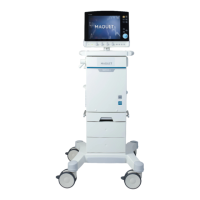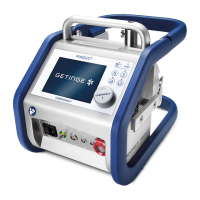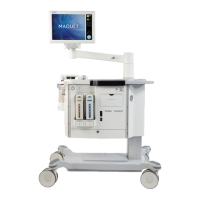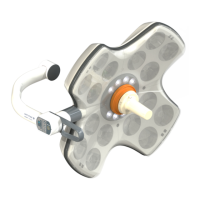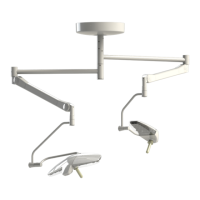Troubleshooting
What happens when:
•
There is no bubbling in the suction
control chamber?
Check to be sure the suction tubing is con-
nected to the chest drain and to the wall
regulator and the suction source is turned
on. Adjusting the suction control stopcock is
required for constant gentle bubbling.
• There is vigorous bubbling in the suction
control chamber?
Vigorous bubbling causes quicker evapora-
tion and produces excessive noise. Constant,
gentle bubbling is all that is required to impose
the prescribed amount of suction. The suc-
tion control stopcock, located on the suction
tubing, can be used to adjust bubbling. The
suction source regulator can also be adjusted
to turn suction control bubbling up or down.
Should the suction control stopcock be
turned off for gravity drainage or for patient
transport?
No. The patient is protected two ways; first
by the one-way valve created by the water
seal to maintain the desired patient vacuum
pressure, and second, the patient is protected
by the integral positive pressure valve in the
event the stopcock is turned off. It is not
necessary to turn off the stopcock, clamp, or
cap the suction line during gravity drainage or
patient transport. Both the water seal and the
positive pressure valve provide patient protec-
tion when either the suction line or stopcock
remain open or closed.
How can I connect multiple chest drains to
one suction source easily?
With models equipped with a suction control
stopcock, connection of two or more chest
drains to a common suction source is made
easier. Place a 1/4” x 1/4” x 1/4” Y connector
on the wall suction tubing.
Cut the drain suction tubing where indicated
in Illustration 1. Now invert the cut sections of
suction tubing as shown in Illustration 2 and
insert them into the suction tubing remaining
on the chest drain.
Now you have two open ends of suction line
tubing for the Y connector to be placed. Turn
on suction and adjust the suction control
stopcock on each drain to achieve constant,
gentle bubbling with each.
How do I confirm my patient has an air leak
when there is:
•
No bubbling in the water seal?
If there are no air bubbles observed going
from right to left in the air leak monitor, there
is no patient air leak. In order to confirm that
your patient’s chest catheter(s) are patent,
temporarily turn suction off and check for
oscillation of the patient pressure float ball in
the water seal column coinciding with patient
respiration.
•
Bubbling present in the water seal?
Whenever constant or intermittent bubbling is
present in the water seal air leak monitor, this
will confirm an air leak is present. Oscillation
of the patient pressure float ball at the bottom
of the water seal without bubbling will indi-
cate no apparent air leak. Bubbling from right
to left must be present to confirm an air leak.
To determine the source of the air leak (patient
or catheter connection), momentarily clamp
the patient tube close to the chest drain and
observe the water seal. If bubbling stops, the
air leak may be from the catheter connections
or the patient’s chest. Check the catheter
connectors and patient dressing for a partially
withdrawn catheter. If bubbling continues after
temporarily clamping the patient tube, this will
indicate a system air leak requiring system
replacement.
If the chest drainage system has been
knocked over, can I use it and what should
I do?
After a chest drainage system has been kno-
cked over, set it upright and immediately
check the fluid levels of the water seal and
suction control chambers for proper volumes.
We provide convenient dia phragms for access
with a 20 gauge or smaller needle and syringe
to adjust the water level in each chamber, if
required. Alcohol swab the needle access area
and aspirate any overfill that may have occur-
red. If the water seal has an inadequate fluid
level, simply replace the lost volume. If a signi-
ficant amount of blood has entered the water
seal, it may be advisable to change the system
for a new one.
How do I lower the water seal column?
Changes in your patient’s pressure will be
reflected by the height of the water in the
water seal column. These changes are usually
due to mechanical means such as milking or
stripping patient drainage tubes, or simply by
deep inspiration by your patient after all air
leaks have subsided. If desired, the height of
the water column and patient pressure can be
reduced by temporarily depressing the filtered
manual vent, located on top of the drain, until
the float valve releases and the water column
lowers to the desired level. Do not lower water
seal column when suction is not operating or
when patient is on gravity drainage.
Is it normal for the patient pressure float
ball to fluctuate up and down (tidal) near the
bottom of the water seal column?
Yes. Once your patient’s air leak is resolved,
you will generally observe moderate tidaling in
the water seal column. Increases in intrathor-
acic pressure will cause the water level to rise
(the ball rises) during patient inspiration and
will lower or decrease (the ball drops) during
expiration. This diagnostic tool will help to
confirm patency of your patient’s catheter(s).
Minor “bouncing” of the water seal level can
also be caused by vigorous bubbling of the
suction control chamber. To accurately assess
patient catheter patency, momentarily occlude
suction to stop the suction control chamber
bubbling and observe the water seal’s physio-
logical response.
How do I dispose of the system?
Disposal of chest drain and its contents
should be in accordance with all applicable
regulations.
Illustration 2.
Insert
Insert “Y”
Cut chest drain
suction line and
insert stopcock
into open tubing
Illustration 1.
Have a question or need help in a hurry?
Call Maquet toll free at 1-800-528-7486.
M Atrium Ocean Chest Drain is manufactured by Atrium Medical Corporation, 5 Wentworth Drive, Hudson NH 03051 603-880-1433. • Protected by the following international and U.S. patent(s): http://patents.maquet.com. • Y CAUTION: Federal (US) law restricts
this device to sale by or on the order of a physician. • Maquet is a Trademark and/or Registered Trademark of Maquet GMBH, its subsidiaries, and/or affiliates in the United States and/or other countries. • Maquet is registered in U.S. Patent and Trademark Office.
• Ocean and Atrium are Trademarks and/or Registered Trademarks of Atrium Medical Corp., its subsidiaries, and/or affiliates in the United States and/or other countries. • Ocean and Atrium are registered in U.S. Patent and Trademark Office. All other company or
product names are the trademarks or registered trademarks of their respective holders. • Copyright 2015 Atrium Medical Corp. or its affiliates. • All rights not expressly granted are reserved. • 03/15 • Part No. 010394 Rev AA Letter. Refer to Instructions for Use for
current indications, warnings, contraindications, and precautions.
Maquet Medical Systems USA | 45 Barbour Pond Drive, Wayne, NJ 07470 | www.maquetusa.com MCV00033029 REVA
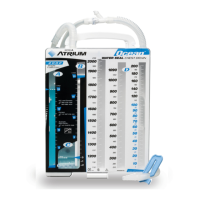
